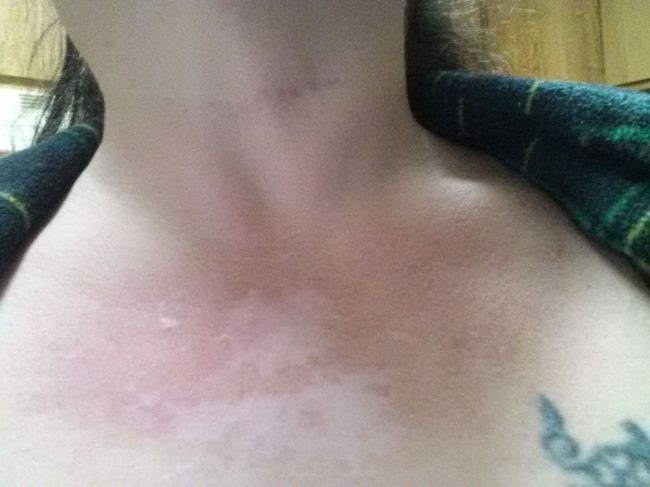It's a little difficult to see in the pic-but I tried to capture not the rash or hives on top of the skin but the bumps underneath the skin. My blood vessels were so inflammed I could follow them up and down my arms-and feel the muscles and nerves of my ulnar and carpal neuropathy being pulled.
The actual term is urticarial vasculitis. It's a hypersensitivity vascular reaction to the UV or the sun-of which many people with lupus have sensitivities with. When mine gets bad-it causes this reaction. I call it a mini-flare-it usually takes about a week to come all the way down, and yes, it ITCHES and yes, it's painful. While I usually have it on my arms, I have had it on my chest and face as well. Here's my chest, only slightly reactive, but still very hot, swollen and itchy:

The discolorations you see on my chest are from previous urticaria rashes, lupus rashes, discoid rashes, lesions and pemphigoid rashes. Here's some info on urticarial vasculitis from medscape:
Urticarial vasculitis is an eruption of erythematous wheals that clinically resemble urticaria but histologically show changes of leukocytoclastic vasculitis.[1, 2] Urticarial vasculitis may be divided into normocomplementemic and hypocomplementemic variants. Both subsets can be associated with systemic symptoms (eg, angioedema, arthralgias, abdominal or chest pain, fever, pulmonary disease, renal disease, episcleritis, uveitis, and Raynaud phenomenon).
The hypocomplementemic form more often is associated with systemic symptoms and has been linked to connective-tissue disease (ie, systemic lupus erythematosus [SLE]).
Patients with urticarial vasculitis present with an urticarial eruption, often accompanied by a painful or burning sensation. Lesions are generalized wheals or erythematous plaques, occasionally with central clearing, lasting for more than 24 hours in a fixed location (in contrast to urticaria, which resolves in minutes to hours or migrates continually). Petechiae may be noted within the lesions, and they may resolve with ecchymoses or postinflammatory hyperpigmentation. Patients may have photosensitivity, lymphadenopathy, arthralgia, angioedema (40%), fever, abdominal pain, dyspnea, and pleural and pericardial effusions.[4] Most cases of urticarial vasculitis are idiopathic.
The primary causes of urticarial vasculitis are as follows:
- Drug induced, such as ACE inhibitors, penicillin, sulfonamides, fluoxetine, cimetidine, diltiazem, thiazides, potassium iodide, non-steroid inflammatory drugs, and glatiramer acetate.[9]
- Rheumatic disease, such as SLE and Sjögren syndrome: Urticarial vasculitis has also been reported with immunoglobulin A and immunoglobulin M monoclonal gammopathies, mixed cryoglobulins, and hematologic and solid malignancies.[10]
- Hypocomplementemia often is associated with a systemic condition, such as SLE (in which >50% of patients have hypocomplementemia).[3] In addition, as many as 71% of patients with hypocomplementemic urticarial vasculitis have a positive antinuclear antibody titer but do not fulfill the American Rheumatism Association criteria for SLE.[5] Some authors have suggested evaluation of hypocomplementemic urticarial vasculitis for immunoglobulin G antibodies to C1q. Individuals with these antibodies have a higher incidence of angioedema, ocular inflammation, glomerulonephritis, and obstructive pulmonary disease.
- Normocomplementemic vasculitis can be associated with connective-tissue disease but at a much lower rate.





ReplyDeleteFor those people who are lupus sufferer and maybe reading this, I find it hard that people are still ignorant when it comes to LUPUS and have no idea what the illness is all about and still flippant about it even in the medical world.
After my daughter collapsed at home she was seen by one of the Consultants in the Lupus Unit who performed more tests and confirmed that she was negative with the Anti-RO antibodies. when I was told this, as I was slowly thinking I was losing my marbles and this was all in my head.
The Doctor prescribed a course of treatment but said that it would take about 8-9 months for the drugs to start working. I felt relieved to think that there was light at the end of the tunnel but still quite daunted by her having to cope feeling the way. After 2months of taken the medication the symptoms seemed to get worse, She had fevers, cold sweats, chest pains, constantly nauseous and she was finding it difficult to breathe. Her Doctor thought that the difficulty breathing may have been caused by one of the anti-inflammatory drugs and stopped them straight away.
But Everything started to get easier from the point we came across Justin Herbal Medicine. When I first contacted Justin he told us that the drugs they'd used had aggravated the Lupus and caused it to flare more badly. The miraculous new treatment (Herbal Medicine) was for her to start the medicine sooner which was my thoughts, which of course was helpful.
His medicine is very effective, she experienced no symptoms for the past 1year. If you/your relative have same problem, do not expose yourself to more danger, use a herbal remedy that is safe and effective. Contact him directly for more info. with this address: lancejustin54@gmail.com